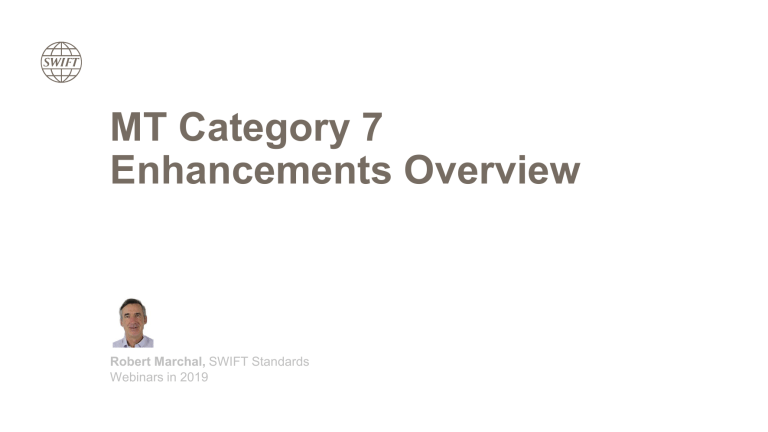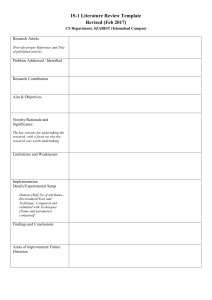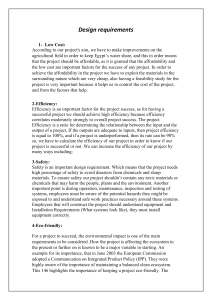
MT Category 7 Enhancements Overview Robert Marchal, SWIFT Standards Webinars in 2019 Agenda Overall Project Presentation Time Line Category 7 changes SR 2020 Feedback on SR 2018 MT 798 2 Overall Project The Trade Finance Maintenance Working Group (TFMWG) launched a significant overhaul of the cat 7 MTs (Letters of credit, guarantees and standby L/Cs) in 2013, taking into account change requests from previous years, and other drivers: requests from the community over the last 10 years straight-through-processing to fill some gaps in transaction flows It is a significant upgrade to the functionality and format of the 700 (L/C) series and 760 (guarantees/standby L/Cs) series of messages, including 9 new MTs The go-live dates are in November 2018 for L/Cs and November 2020 for guarantees/standby L/Cs (initially 2019, then deferred to 2020). 3 The detailed implementation and documentation time line is as follows: Q1 JAN 2016 FEB Q2 MAR L/Cs 2019 2020 Guarantees / standby L/Cs MAY JUN JUL AUG Annual Deadline for CR Advance Documentation Advance Documentation 2017 2018 APR Q3 Vendor Test Bed (VTB) Annual Deadline for CR Advance Documentation 2020 Vendor Test Bed (VTB) Annual Deadline for CR Vendor Test Bed (VTB) Annual Deadline for CR Power Point template - You can edit footer content by going into 'Insert' tab > 'Header & Footer' SEP OCT NOV DEC Readiness Portal My Standards Annual Deadline for CR Advance Documentation 2020 Q4 LIVE SRG Documentation UHB Documentation LIVE Test & Training (T&T) Test & Training (T&T) UHB Documentation LIVE SRG Documentation LIVE Test & Training (T&T) 4 5 Training and Webinars Worldwide webinars SwiftSmart will have specific modules and training on category 7, SR 2018 (as of January 2018) and SR 2020 (in 2019). 6 Summary – Evolution in Category 7 Limited functionality Major revamp Staggered Release Large portions of free text New fields added Published advance documentation Limited character set Z-character set in long text fields Few coded fields Codes introduced SR 2018 MT 700-759 3 new messages More validation SR 2020 MT 760-787 6 new messages 7 MT Category 7 Update: New messages Documentary Credits MT 708 Amendment to a Documentary Credit MT 744 Notice of Non-Conforming Reimbursement Claim Guarantees/Standbys MT 761 Issue of a Demand Guarantee/Standby Letter of Credit (cont.) MT 765 Guarantee/Standby Letter of Credit Demand MT 775 Amendment to a Demand Guarantee/Standby Letter of Credit (cont.) MT 785 Guarantee/Standby Letter of Credit Non Extension Notification MT 786 Guarantee/Standby Letter of Credit Demand Refusal MT 787 Guarantee/Standby Letter of Credit Amendment Response All Cat 7 MT 759 Ancillary Trade Structured Message 8 MT Category 7 Updates General – L/Cs and Guarantees/Standby L/Cs Creation of a message MT 759 (Ancillary Trade Structured Message) similar to MT 799 but using a number of coded and structured fields X Adoption of extended “Z” character set for long fields (e.g. 45A, 46A, 47A, 71, 72, 73, 77) Z 9 Changes for SR 2020: Guarantees and Standby Letters of Credit MT 760 & MT 767 are significantly enhanced - Previously had few structured fields and one large free-format field New versions are highly detailed and structured Sequences introduced to cater for undertaking details as well as local undertaking details MT 768 & MT 769 - Field 71B change to 71D with z-character set Field 72 change to 72Z with z-character set New field 23X with codes to identify the delivery channel SR 2020 Current … 11 Guarantees and Standby Letters of Credit General overview message structure of new MT 760 MT 760 Sequence A General Information Sequence B Undertaking Details Sequence C Local Undertaking Details The revised MT 760 message consists primarily of structured fields and fields with coded options (e.g. amount, parties, expiry details, etc.) The message has been designed with three blocks: MT 761 MT 761 Wording of Undertaking or Counter-Undertaking Requested wording for Local Undertaking The extension message MT 761 message consists primarily of a big free text block in order to specify the wording of the undertaking/counter-undertaking as well as the requested wording for the local undertaking – if applicable Up to 7 Up to a maximum of 7 MT 761 messages can follow the MT 760 message Sequence A: General information Sequence B: indicates the details of the undertaking or counter-undertaking Sequence C: (optional) indicates the details of the requested local undertaking 12 MT 765 Scope MT 765 Format Specifications This message is sent by a party (as the beneficiary or on behalf of the beneficiary) to a party which has issued an undertaking (guarantee, demand guarantee, standby letter of credit or dependent undertaking), either directly or via a third party. It is used to demand payment under an undertaking and may include a request to extend the expiry date. The demand itself must be specified as narrative text within the message. It may indicate availability of supporting documentation in addition to the demand. 13 MT 785 Scope MT 785 Format Specifications This message is sent in one of two ways: By the party that issued the undertaking (guarantee, demand guarantee, standby letter of credit or dependent undertaking) to the beneficiary (that is, only in case of beneficiary being a financial institution) or to a nominated advising party that advised the undertaking to the beneficiary or to another advising party By the party that issued the counterundertaking (counter-guarantee or counter-standby) to the beneficiary of the counter-undertaking (financial institution) It is used to notify the beneficiary, if applicable, via one or more advising parties of the non-extension of the referenced undertaking beyond the current expiry date. 14 MT 786 Scope MT 786 Format Specifications This message is sent by the party that issued the undertaking (guarantee, demand guarantee, standby letter of credit or dependent undertaking) to a bank as the beneficiary or to the presenter of the demand, either directly or via a third party. It is used by the party obligated on the undertaking and to whom a demand for payment has been made, to notify the beneficiary that the demand has been refused. The reason(s) giving cause for refusal must be specified as narrative text within the message. 15 MT 787 Scope MT 787 Format Specifications This message is sent in one of two ways: By the beneficiary when the beneficiary is a financial institution By a nominated advising party that advised the undertaking amendment to the beneficiary or advised the undertaking amendment to another advising party It is sent to the bank that issued the undertaking amendment (guarantee, demand guarantee, standby letter of credit or dependent undertaking), either directly or via one or more advising parties, to indicate acceptance or rejection by the beneficiary of the amendment. 16 Other Changes for SR 2020 Addition of field 23X File Identification in all messages MT 768, 769: character set Z allowed in “Details of Charges” and “Sender to Receiver Information” After SR 2020, guarantees and standby L/Cs may not be issued using the MT 700 anymore. The related codes will be removed from MT 700. MT 760 must be used. 17 Agenda Overall Project Presentation Time Line Category 7 changes SR 2020 Feedback on SR 2018 MT 798 18 Good usage of codes in new MT 707/708 (SR 2018) ADD/DELETE/REPALL codes introduced for fields 45B, 46B, 47B, 49M, 49N. These codes are for straight-through processing and must be used without any instructions in natural language, like “please add or replace this” ADD adds texts at the end of the current text (before this amendment) DELETE followed by ADD acts as a “replace” ADD or DELETE acts once, not multiple times FAQ document and Webinars for more details and training 19 MT 798 Trade Guidelines The category 7 MTs are bank-to-bank messages. In the corporate-to-bank space, MT 798 guidelines have been developed. The MT 798 is used as an envelope message, with specific fields, or entire bank-to-bank MTs included in field 77E Applicant The MT 798 Guideline specification (currently implemented is V5) was upgraded to take into account the category 7 changes. It also includes various enhancements. MT 798 MIG V5 was firstly published in July 2017. Updated in 2018 These changes will “go live” at the same time than the corresponding MTs. Issuing Bank Advising Bank Beneficiary 20 Major Work Items for MT 798 V5 Alignment of MT 798 guidelines to updated interbank MT SR 2018-2020 New and consistent references in all flows (21A and P, 21S and T) Index message is now the same for guarantee or standby LC (was different in V4) New flows Drafting process 21 Thank you Your SWIFT Standards contacts: David Dobbing Sydney, Australia david.dobbing@swift.com Robert Marchal Belgium robert.marchal@swift.com 22 Questions Useful links Standards Release Page https://www.swift.com/standards/standards-releases/releasehighlights?tl=en Release Highlights Page https://www.swift.com/standards/standards-releases/releasehighlights?tl=en#topic-tabs-menu SR 2018 documentation https://www2.swift.com/uhbonline/books/public/en_uk/srg_20171222/index.h tm Advance documentation for SR 2020 https://www.swift.com/resource/category-7-advance-information-0 MT 798 V5 Specification https://www2.swift.com/uhbonline/books/public/en_uk/s_corp_stdsmt_msg_i mpl_guid_vol_2_trd_fnc_std/index.htm 24 MT 759 25 MT 759 Ancillary Trade Structured Message 26 Field 23H: Function 27


